CHCECE003
VerifiedAdded on 2023/06/17
|12
|2696
|88
AI Summary
This article provides answers to questions related to CHCECE003, including encouraging children to participate in physical experiences, sun protection procedures, creative play, and more. It also includes a performance task and strategies for adapting facilities and providing challenging elements to children in outdoor and indoor environments.
Contribute Materials
Your contribution can guide someone’s learning journey. Share your
documents today.

CHCECE003
Secure Best Marks with AI Grader
Need help grading? Try our AI Grader for instant feedback on your assignments.
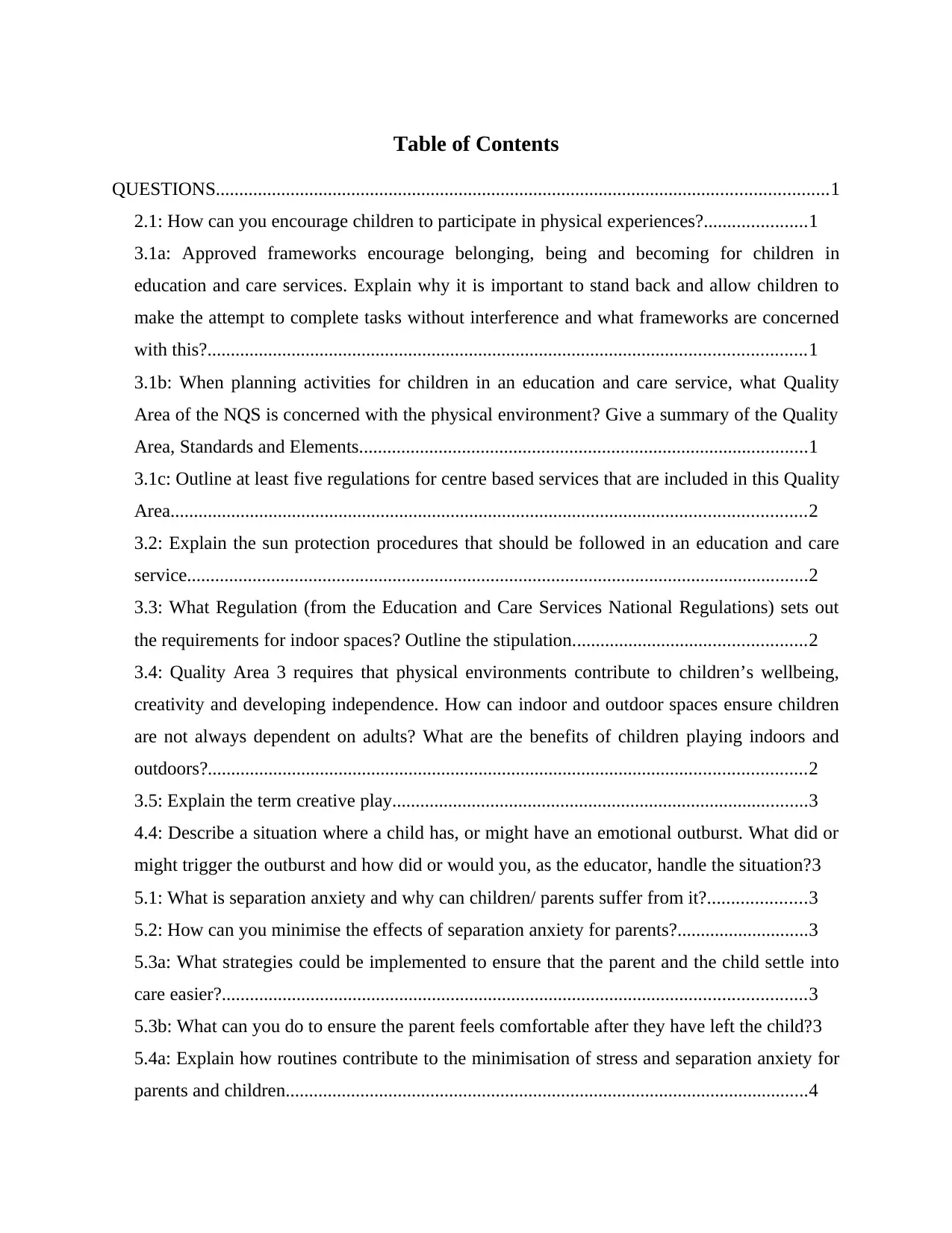
Table of Contents
QUESTIONS...................................................................................................................................1
2.1: How can you encourage children to participate in physical experiences?......................1
3.1a: Approved frameworks encourage belonging, being and becoming for children in
education and care services. Explain why it is important to stand back and allow children to
make the attempt to complete tasks without interference and what frameworks are concerned
with this?................................................................................................................................1
3.1b: When planning activities for children in an education and care service, what Quality
Area of the NQS is concerned with the physical environment? Give a summary of the Quality
Area, Standards and Elements................................................................................................1
3.1c: Outline at least five regulations for centre based services that are included in this Quality
Area........................................................................................................................................2
3.2: Explain the sun protection procedures that should be followed in an education and care
service.....................................................................................................................................2
3.3: What Regulation (from the Education and Care Services National Regulations) sets out
the requirements for indoor spaces? Outline the stipulation..................................................2
3.4: Quality Area 3 requires that physical environments contribute to children’s wellbeing,
creativity and developing independence. How can indoor and outdoor spaces ensure children
are not always dependent on adults? What are the benefits of children playing indoors and
outdoors?................................................................................................................................2
3.5: Explain the term creative play.........................................................................................3
4.4: Describe a situation where a child has, or might have an emotional outburst. What did or
might trigger the outburst and how did or would you, as the educator, handle the situation?3
5.1: What is separation anxiety and why can children/ parents suffer from it?.....................3
5.2: How can you minimise the effects of separation anxiety for parents?............................3
5.3a: What strategies could be implemented to ensure that the parent and the child settle into
care easier?.............................................................................................................................3
5.3b: What can you do to ensure the parent feels comfortable after they have left the child?3
5.4a: Explain how routines contribute to the minimisation of stress and separation anxiety for
parents and children................................................................................................................4
QUESTIONS...................................................................................................................................1
2.1: How can you encourage children to participate in physical experiences?......................1
3.1a: Approved frameworks encourage belonging, being and becoming for children in
education and care services. Explain why it is important to stand back and allow children to
make the attempt to complete tasks without interference and what frameworks are concerned
with this?................................................................................................................................1
3.1b: When planning activities for children in an education and care service, what Quality
Area of the NQS is concerned with the physical environment? Give a summary of the Quality
Area, Standards and Elements................................................................................................1
3.1c: Outline at least five regulations for centre based services that are included in this Quality
Area........................................................................................................................................2
3.2: Explain the sun protection procedures that should be followed in an education and care
service.....................................................................................................................................2
3.3: What Regulation (from the Education and Care Services National Regulations) sets out
the requirements for indoor spaces? Outline the stipulation..................................................2
3.4: Quality Area 3 requires that physical environments contribute to children’s wellbeing,
creativity and developing independence. How can indoor and outdoor spaces ensure children
are not always dependent on adults? What are the benefits of children playing indoors and
outdoors?................................................................................................................................2
3.5: Explain the term creative play.........................................................................................3
4.4: Describe a situation where a child has, or might have an emotional outburst. What did or
might trigger the outburst and how did or would you, as the educator, handle the situation?3
5.1: What is separation anxiety and why can children/ parents suffer from it?.....................3
5.2: How can you minimise the effects of separation anxiety for parents?............................3
5.3a: What strategies could be implemented to ensure that the parent and the child settle into
care easier?.............................................................................................................................3
5.3b: What can you do to ensure the parent feels comfortable after they have left the child?3
5.4a: Explain how routines contribute to the minimisation of stress and separation anxiety for
parents and children................................................................................................................4
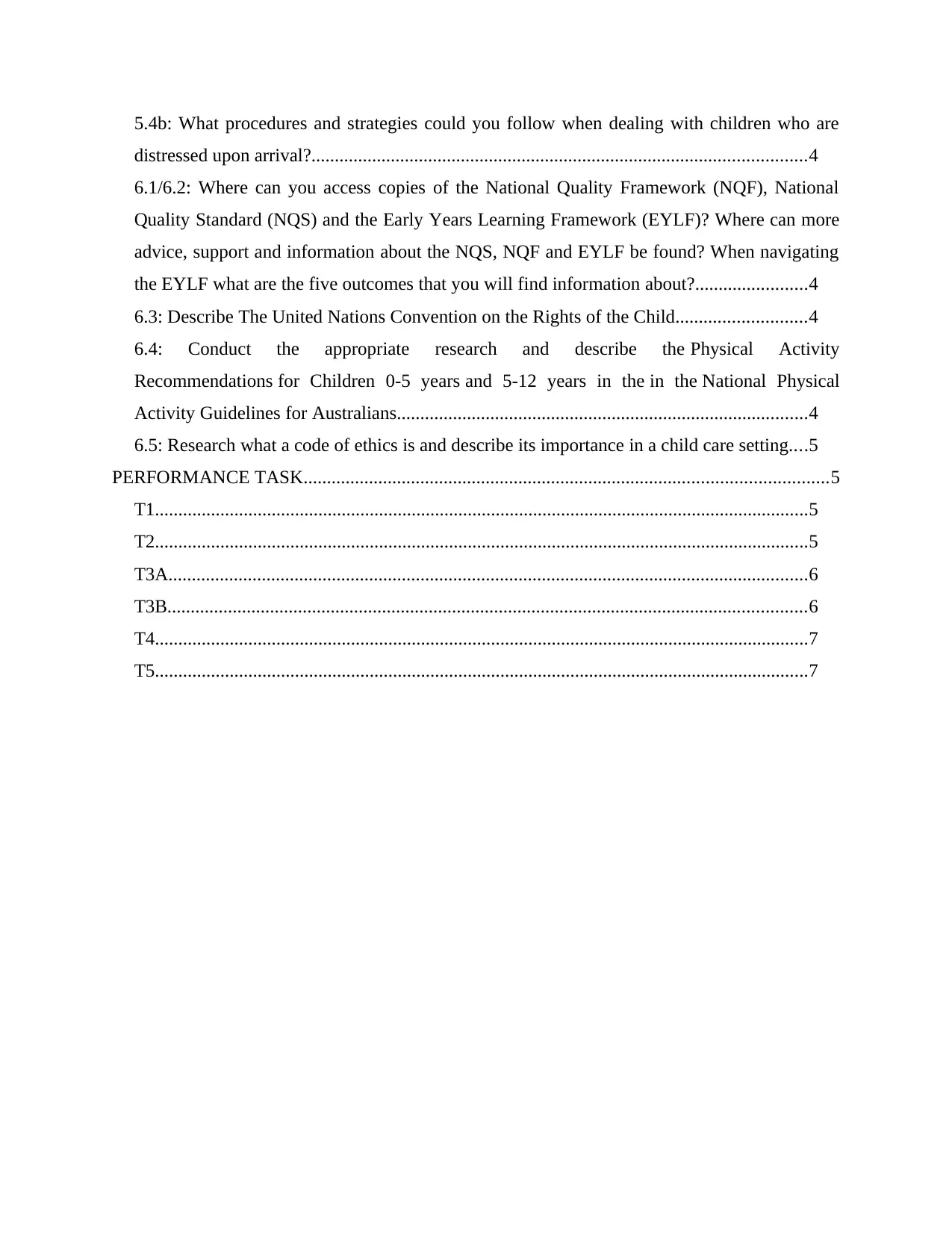
5.4b: What procedures and strategies could you follow when dealing with children who are
distressed upon arrival?..........................................................................................................4
6.1/6.2: Where can you access copies of the National Quality Framework (NQF), National
Quality Standard (NQS) and the Early Years Learning Framework (EYLF)? Where can more
advice, support and information about the NQS, NQF and EYLF be found? When navigating
the EYLF what are the five outcomes that you will find information about?........................4
6.3: Describe The United Nations Convention on the Rights of the Child............................4
6.4: Conduct the appropriate research and describe the Physical Activity
Recommendations for Children 0-5 years and 5-12 years in the in the National Physical
Activity Guidelines for Australians........................................................................................4
6.5: Research what a code of ethics is and describe its importance in a child care setting....5
PERFORMANCE TASK................................................................................................................5
T1............................................................................................................................................5
T2............................................................................................................................................5
T3A.........................................................................................................................................6
T3B.........................................................................................................................................6
T4............................................................................................................................................7
T5............................................................................................................................................7
distressed upon arrival?..........................................................................................................4
6.1/6.2: Where can you access copies of the National Quality Framework (NQF), National
Quality Standard (NQS) and the Early Years Learning Framework (EYLF)? Where can more
advice, support and information about the NQS, NQF and EYLF be found? When navigating
the EYLF what are the five outcomes that you will find information about?........................4
6.3: Describe The United Nations Convention on the Rights of the Child............................4
6.4: Conduct the appropriate research and describe the Physical Activity
Recommendations for Children 0-5 years and 5-12 years in the in the National Physical
Activity Guidelines for Australians........................................................................................4
6.5: Research what a code of ethics is and describe its importance in a child care setting....5
PERFORMANCE TASK................................................................................................................5
T1............................................................................................................................................5
T2............................................................................................................................................5
T3A.........................................................................................................................................6
T3B.........................................................................................................................................6
T4............................................................................................................................................7
T5............................................................................................................................................7

QUESTIONS
2.1: How can you encourage children to participate in physical experiences?
In this, there are some ways which is refers to children which help to encourage for the
participation in the physical experience are:
Discuss with the child doctor, because the child doctor may help to understand the child
in physical activity is important.
Emphasize fun activities.
Plan for the activities which is based on physical experience.
Be the role model.
Play with the children.
Choose the activity which is based on development on the basis of functions and outdoor
games.
3.1a: Approved frameworks encourage belonging, being and becoming for children in education
and care services. Explain why it is important to stand back and allow children to make the
attempt to complete tasks without interference and what frameworks are concerned with
this?
This help to allow the children to take the foster of self-reliance that based on child that may feel
to control over their life. It may also help to develop the vital qualities which majorly include the
patience, concentration, self-cooperation and the self-factor that based on discipline and trust
development for the own.
3.1b: When planning activities for children in an education and care service, what Quality Area
of the NQS is concerned with the physical environment? Give a summary of the Quality
Area, Standards and Elements.
The quality area 3 is refer as the national quality standard which allow children to make ensure
that the physical environment is safe, appropriate for the children and provide a rich and diverse
range of experience which help to promote the children learning and accountability of
development.
1
2.1: How can you encourage children to participate in physical experiences?
In this, there are some ways which is refers to children which help to encourage for the
participation in the physical experience are:
Discuss with the child doctor, because the child doctor may help to understand the child
in physical activity is important.
Emphasize fun activities.
Plan for the activities which is based on physical experience.
Be the role model.
Play with the children.
Choose the activity which is based on development on the basis of functions and outdoor
games.
3.1a: Approved frameworks encourage belonging, being and becoming for children in education
and care services. Explain why it is important to stand back and allow children to make the
attempt to complete tasks without interference and what frameworks are concerned with
this?
This help to allow the children to take the foster of self-reliance that based on child that may feel
to control over their life. It may also help to develop the vital qualities which majorly include the
patience, concentration, self-cooperation and the self-factor that based on discipline and trust
development for the own.
3.1b: When planning activities for children in an education and care service, what Quality Area
of the NQS is concerned with the physical environment? Give a summary of the Quality
Area, Standards and Elements.
The quality area 3 is refer as the national quality standard which allow children to make ensure
that the physical environment is safe, appropriate for the children and provide a rich and diverse
range of experience which help to promote the children learning and accountability of
development.
1
Secure Best Marks with AI Grader
Need help grading? Try our AI Grader for instant feedback on your assignments.
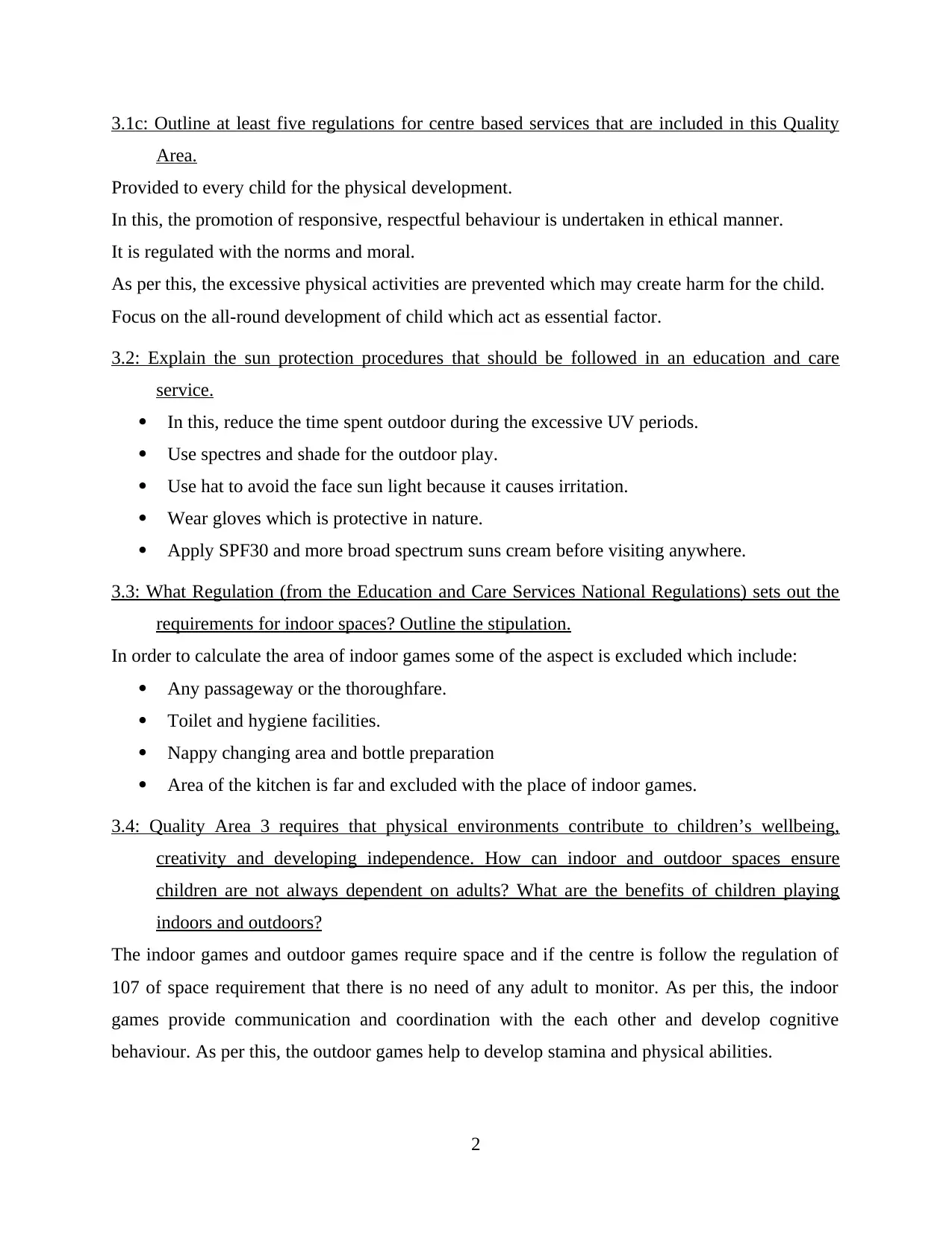
3.1c: Outline at least five regulations for centre based services that are included in this Quality
Area.
Provided to every child for the physical development.
In this, the promotion of responsive, respectful behaviour is undertaken in ethical manner.
It is regulated with the norms and moral.
As per this, the excessive physical activities are prevented which may create harm for the child.
Focus on the all-round development of child which act as essential factor.
3.2: Explain the sun protection procedures that should be followed in an education and care
service.
In this, reduce the time spent outdoor during the excessive UV periods.
Use spectres and shade for the outdoor play.
Use hat to avoid the face sun light because it causes irritation.
Wear gloves which is protective in nature.
Apply SPF30 and more broad spectrum suns cream before visiting anywhere.
3.3: What Regulation (from the Education and Care Services National Regulations) sets out the
requirements for indoor spaces? Outline the stipulation.
In order to calculate the area of indoor games some of the aspect is excluded which include:
Any passageway or the thoroughfare.
Toilet and hygiene facilities.
Nappy changing area and bottle preparation
Area of the kitchen is far and excluded with the place of indoor games.
3.4: Quality Area 3 requires that physical environments contribute to children’s wellbeing,
creativity and developing independence. How can indoor and outdoor spaces ensure
children are not always dependent on adults? What are the benefits of children playing
indoors and outdoors?
The indoor games and outdoor games require space and if the centre is follow the regulation of
107 of space requirement that there is no need of any adult to monitor. As per this, the indoor
games provide communication and coordination with the each other and develop cognitive
behaviour. As per this, the outdoor games help to develop stamina and physical abilities.
2
Area.
Provided to every child for the physical development.
In this, the promotion of responsive, respectful behaviour is undertaken in ethical manner.
It is regulated with the norms and moral.
As per this, the excessive physical activities are prevented which may create harm for the child.
Focus on the all-round development of child which act as essential factor.
3.2: Explain the sun protection procedures that should be followed in an education and care
service.
In this, reduce the time spent outdoor during the excessive UV periods.
Use spectres and shade for the outdoor play.
Use hat to avoid the face sun light because it causes irritation.
Wear gloves which is protective in nature.
Apply SPF30 and more broad spectrum suns cream before visiting anywhere.
3.3: What Regulation (from the Education and Care Services National Regulations) sets out the
requirements for indoor spaces? Outline the stipulation.
In order to calculate the area of indoor games some of the aspect is excluded which include:
Any passageway or the thoroughfare.
Toilet and hygiene facilities.
Nappy changing area and bottle preparation
Area of the kitchen is far and excluded with the place of indoor games.
3.4: Quality Area 3 requires that physical environments contribute to children’s wellbeing,
creativity and developing independence. How can indoor and outdoor spaces ensure
children are not always dependent on adults? What are the benefits of children playing
indoors and outdoors?
The indoor games and outdoor games require space and if the centre is follow the regulation of
107 of space requirement that there is no need of any adult to monitor. As per this, the indoor
games provide communication and coordination with the each other and develop cognitive
behaviour. As per this, the outdoor games help to develop stamina and physical abilities.
2
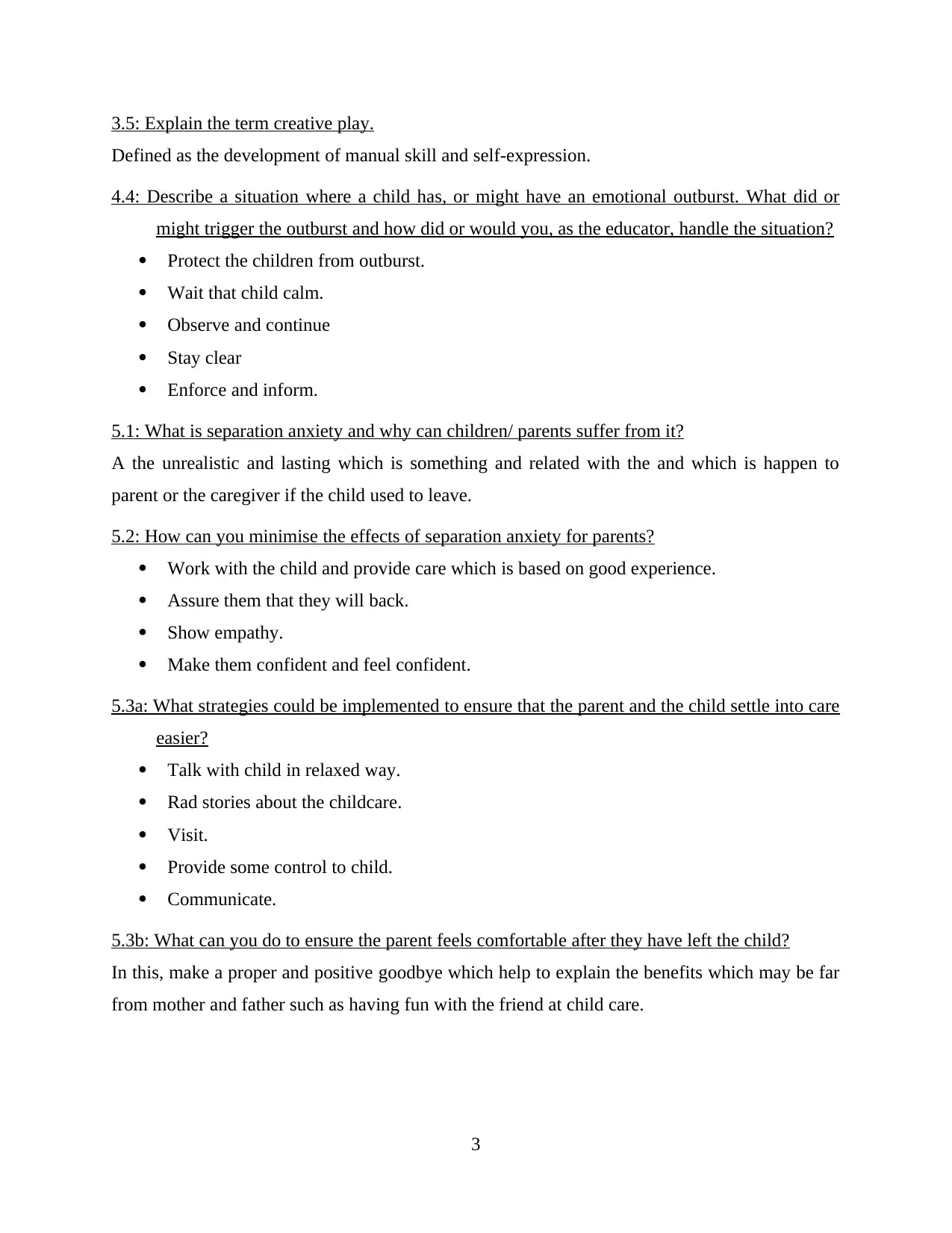
3.5: Explain the term creative play.
Defined as the development of manual skill and self-expression.
4.4: Describe a situation where a child has, or might have an emotional outburst. What did or
might trigger the outburst and how did or would you, as the educator, handle the situation?
Protect the children from outburst.
Wait that child calm.
Observe and continue
Stay clear
Enforce and inform.
5.1: What is separation anxiety and why can children/ parents suffer from it?
A the unrealistic and lasting which is something and related with the and which is happen to
parent or the caregiver if the child used to leave.
5.2: How can you minimise the effects of separation anxiety for parents?
Work with the child and provide care which is based on good experience.
Assure them that they will back.
Show empathy.
Make them confident and feel confident.
5.3a: What strategies could be implemented to ensure that the parent and the child settle into care
easier?
Talk with child in relaxed way.
Rad stories about the childcare.
Visit.
Provide some control to child.
Communicate.
5.3b: What can you do to ensure the parent feels comfortable after they have left the child?
In this, make a proper and positive goodbye which help to explain the benefits which may be far
from mother and father such as having fun with the friend at child care.
3
Defined as the development of manual skill and self-expression.
4.4: Describe a situation where a child has, or might have an emotional outburst. What did or
might trigger the outburst and how did or would you, as the educator, handle the situation?
Protect the children from outburst.
Wait that child calm.
Observe and continue
Stay clear
Enforce and inform.
5.1: What is separation anxiety and why can children/ parents suffer from it?
A the unrealistic and lasting which is something and related with the and which is happen to
parent or the caregiver if the child used to leave.
5.2: How can you minimise the effects of separation anxiety for parents?
Work with the child and provide care which is based on good experience.
Assure them that they will back.
Show empathy.
Make them confident and feel confident.
5.3a: What strategies could be implemented to ensure that the parent and the child settle into care
easier?
Talk with child in relaxed way.
Rad stories about the childcare.
Visit.
Provide some control to child.
Communicate.
5.3b: What can you do to ensure the parent feels comfortable after they have left the child?
In this, make a proper and positive goodbye which help to explain the benefits which may be far
from mother and father such as having fun with the friend at child care.
3
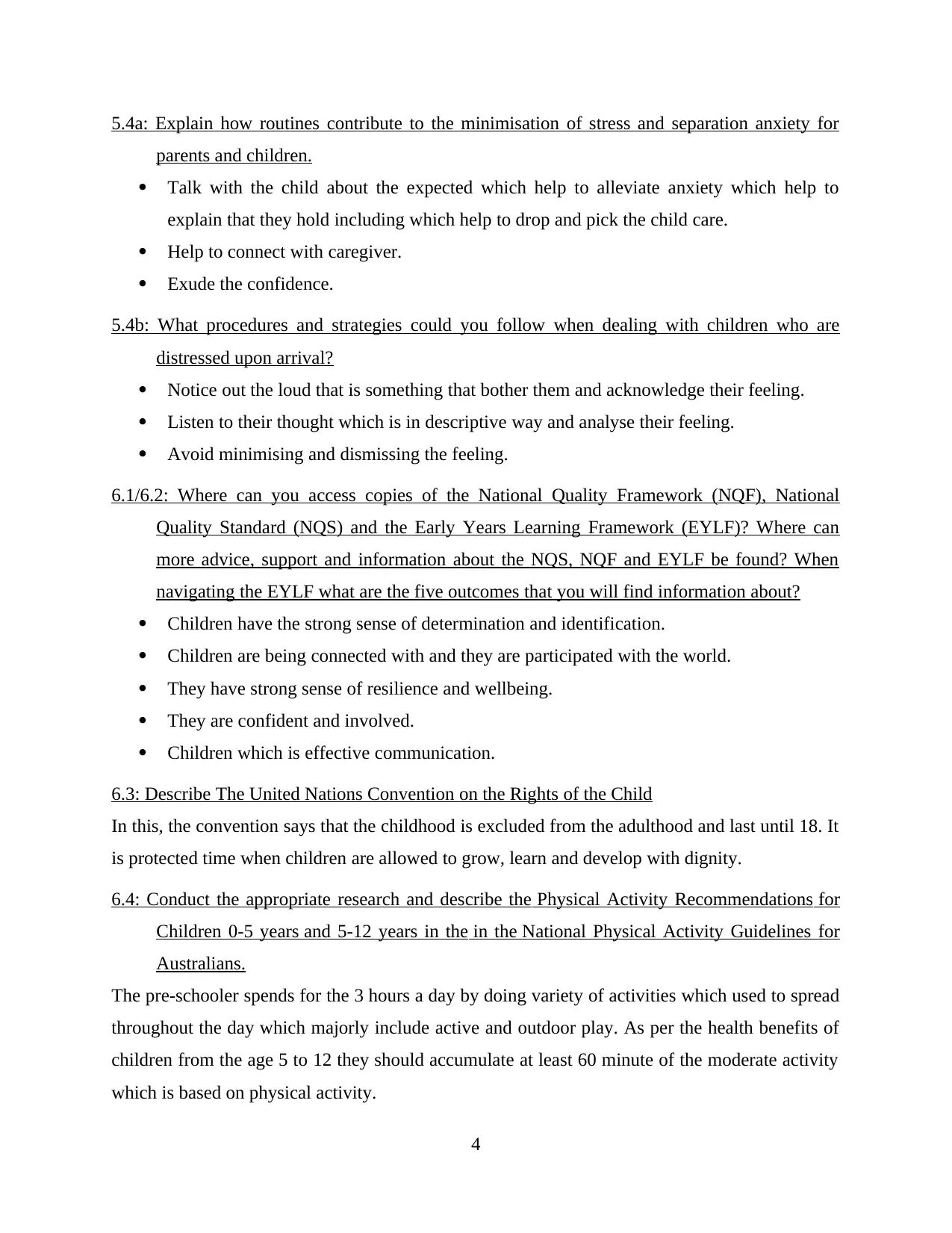
5.4a: Explain how routines contribute to the minimisation of stress and separation anxiety for
parents and children.
Talk with the child about the expected which help to alleviate anxiety which help to
explain that they hold including which help to drop and pick the child care.
Help to connect with caregiver.
Exude the confidence.
5.4b: What procedures and strategies could you follow when dealing with children who are
distressed upon arrival?
Notice out the loud that is something that bother them and acknowledge their feeling.
Listen to their thought which is in descriptive way and analyse their feeling.
Avoid minimising and dismissing the feeling.
6.1/6.2: Where can you access copies of the National Quality Framework (NQF), National
Quality Standard (NQS) and the Early Years Learning Framework (EYLF)? Where can
more advice, support and information about the NQS, NQF and EYLF be found? When
navigating the EYLF what are the five outcomes that you will find information about?
Children have the strong sense of determination and identification.
Children are being connected with and they are participated with the world.
They have strong sense of resilience and wellbeing.
They are confident and involved.
Children which is effective communication.
6.3: Describe The United Nations Convention on the Rights of the Child
In this, the convention says that the childhood is excluded from the adulthood and last until 18. It
is protected time when children are allowed to grow, learn and develop with dignity.
6.4: Conduct the appropriate research and describe the Physical Activity Recommendations for
Children 0-5 years and 5-12 years in the in the National Physical Activity Guidelines for
Australians.
The pre-schooler spends for the 3 hours a day by doing variety of activities which used to spread
throughout the day which majorly include active and outdoor play. As per the health benefits of
children from the age 5 to 12 they should accumulate at least 60 minute of the moderate activity
which is based on physical activity.
4
parents and children.
Talk with the child about the expected which help to alleviate anxiety which help to
explain that they hold including which help to drop and pick the child care.
Help to connect with caregiver.
Exude the confidence.
5.4b: What procedures and strategies could you follow when dealing with children who are
distressed upon arrival?
Notice out the loud that is something that bother them and acknowledge their feeling.
Listen to their thought which is in descriptive way and analyse their feeling.
Avoid minimising and dismissing the feeling.
6.1/6.2: Where can you access copies of the National Quality Framework (NQF), National
Quality Standard (NQS) and the Early Years Learning Framework (EYLF)? Where can
more advice, support and information about the NQS, NQF and EYLF be found? When
navigating the EYLF what are the five outcomes that you will find information about?
Children have the strong sense of determination and identification.
Children are being connected with and they are participated with the world.
They have strong sense of resilience and wellbeing.
They are confident and involved.
Children which is effective communication.
6.3: Describe The United Nations Convention on the Rights of the Child
In this, the convention says that the childhood is excluded from the adulthood and last until 18. It
is protected time when children are allowed to grow, learn and develop with dignity.
6.4: Conduct the appropriate research and describe the Physical Activity Recommendations for
Children 0-5 years and 5-12 years in the in the National Physical Activity Guidelines for
Australians.
The pre-schooler spends for the 3 hours a day by doing variety of activities which used to spread
throughout the day which majorly include active and outdoor play. As per the health benefits of
children from the age 5 to 12 they should accumulate at least 60 minute of the moderate activity
which is based on physical activity.
4
Paraphrase This Document
Need a fresh take? Get an instant paraphrase of this document with our AI Paraphraser
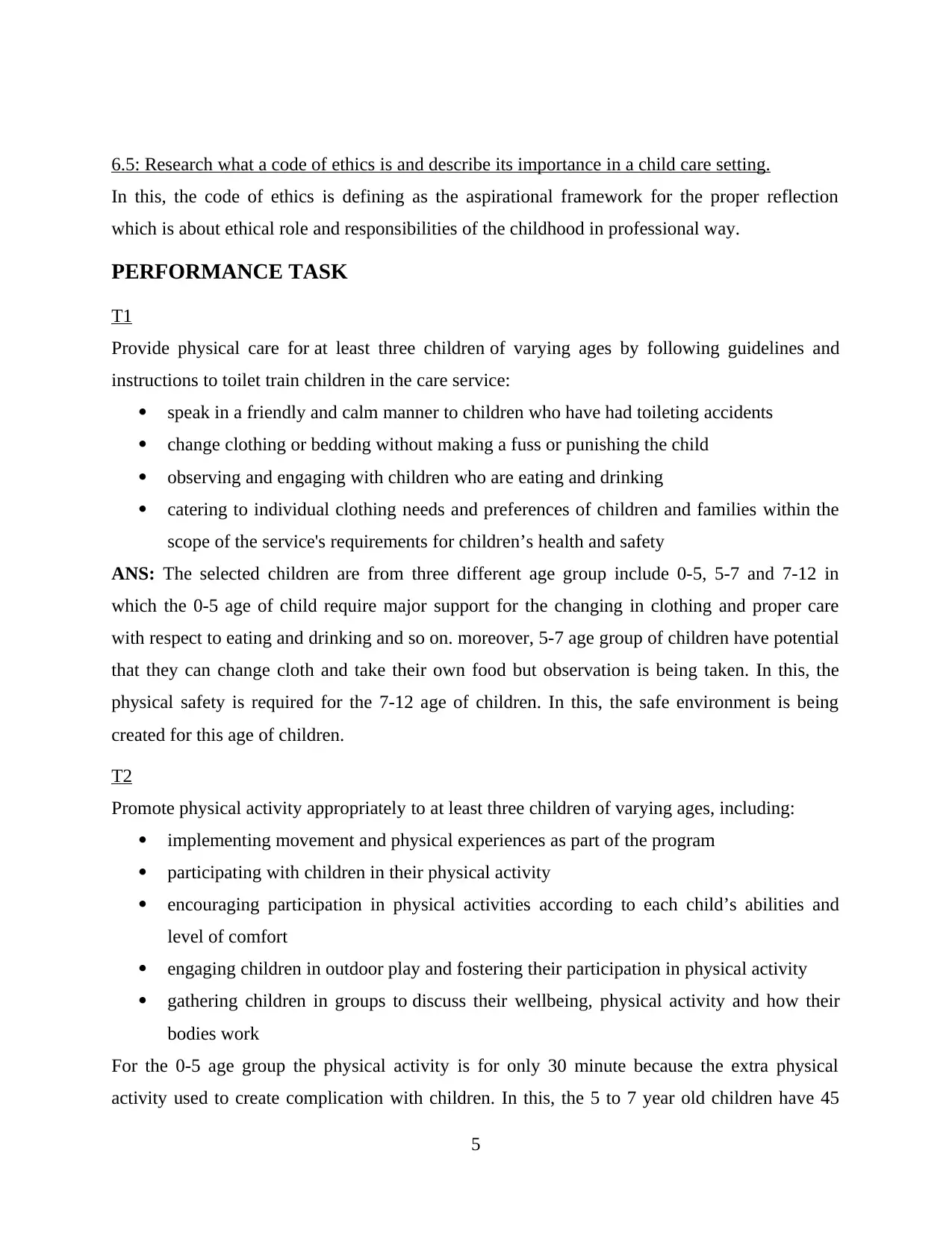
6.5: Research what a code of ethics is and describe its importance in a child care setting.
In this, the code of ethics is defining as the aspirational framework for the proper reflection
which is about ethical role and responsibilities of the childhood in professional way.
PERFORMANCE TASK
T1
Provide physical care for at least three children of varying ages by following guidelines and
instructions to toilet train children in the care service:
speak in a friendly and calm manner to children who have had toileting accidents
change clothing or bedding without making a fuss or punishing the child
observing and engaging with children who are eating and drinking
catering to individual clothing needs and preferences of children and families within the
scope of the service's requirements for children’s health and safety
ANS: The selected children are from three different age group include 0-5, 5-7 and 7-12 in
which the 0-5 age of child require major support for the changing in clothing and proper care
with respect to eating and drinking and so on. moreover, 5-7 age group of children have potential
that they can change cloth and take their own food but observation is being taken. In this, the
physical safety is required for the 7-12 age of children. In this, the safe environment is being
created for this age of children.
T2
Promote physical activity appropriately to at least three children of varying ages, including:
implementing movement and physical experiences as part of the program
participating with children in their physical activity
encouraging participation in physical activities according to each child’s abilities and
level of comfort
engaging children in outdoor play and fostering their participation in physical activity
gathering children in groups to discuss their wellbeing, physical activity and how their
bodies work
For the 0-5 age group the physical activity is for only 30 minute because the extra physical
activity used to create complication with children. In this, the 5 to 7 year old children have 45
5
In this, the code of ethics is defining as the aspirational framework for the proper reflection
which is about ethical role and responsibilities of the childhood in professional way.
PERFORMANCE TASK
T1
Provide physical care for at least three children of varying ages by following guidelines and
instructions to toilet train children in the care service:
speak in a friendly and calm manner to children who have had toileting accidents
change clothing or bedding without making a fuss or punishing the child
observing and engaging with children who are eating and drinking
catering to individual clothing needs and preferences of children and families within the
scope of the service's requirements for children’s health and safety
ANS: The selected children are from three different age group include 0-5, 5-7 and 7-12 in
which the 0-5 age of child require major support for the changing in clothing and proper care
with respect to eating and drinking and so on. moreover, 5-7 age group of children have potential
that they can change cloth and take their own food but observation is being taken. In this, the
physical safety is required for the 7-12 age of children. In this, the safe environment is being
created for this age of children.
T2
Promote physical activity appropriately to at least three children of varying ages, including:
implementing movement and physical experiences as part of the program
participating with children in their physical activity
encouraging participation in physical activities according to each child’s abilities and
level of comfort
engaging children in outdoor play and fostering their participation in physical activity
gathering children in groups to discuss their wellbeing, physical activity and how their
bodies work
For the 0-5 age group the physical activity is for only 30 minute because the extra physical
activity used to create complication with children. In this, the 5 to 7 year old children have 45
5
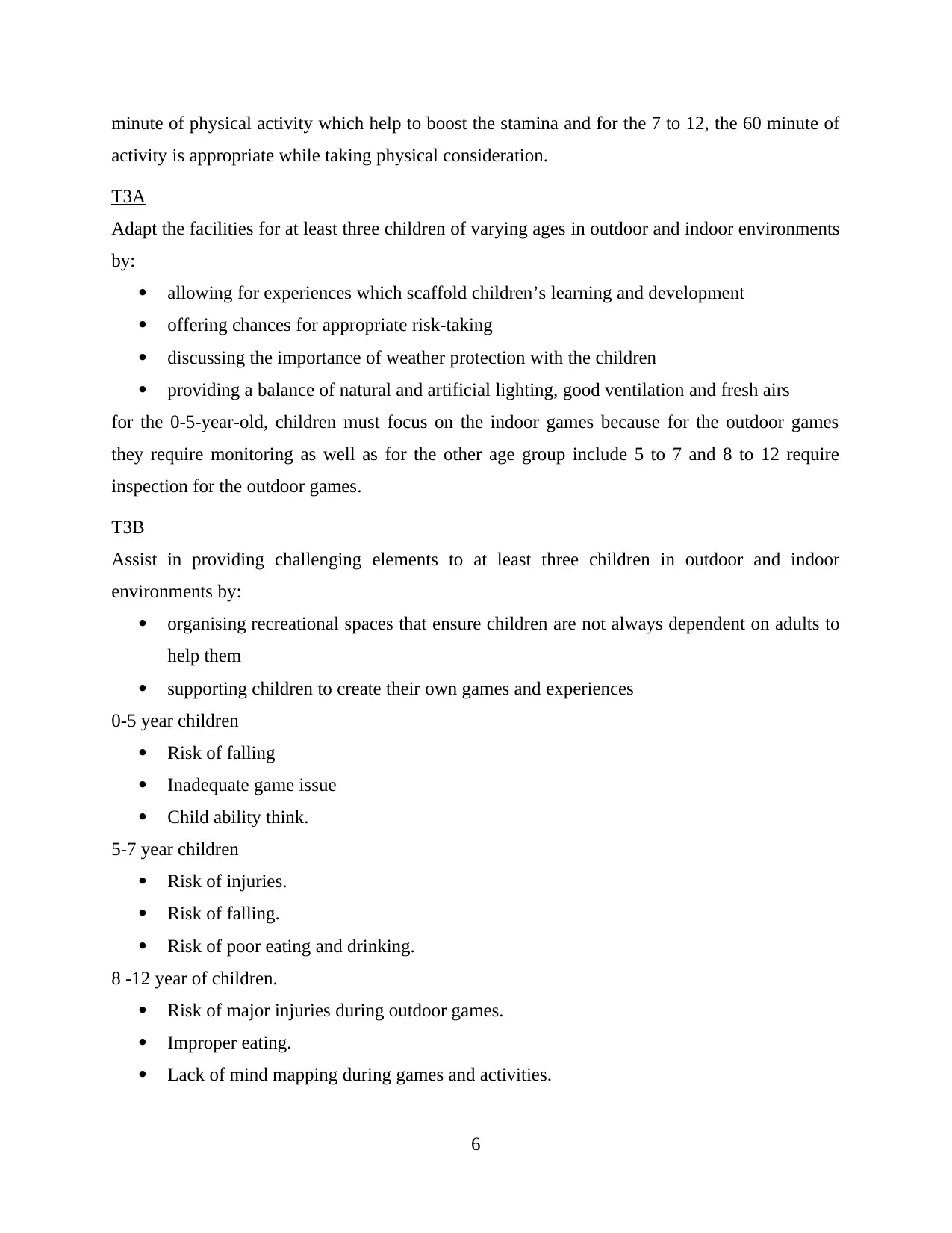
minute of physical activity which help to boost the stamina and for the 7 to 12, the 60 minute of
activity is appropriate while taking physical consideration.
T3A
Adapt the facilities for at least three children of varying ages in outdoor and indoor environments
by:
allowing for experiences which scaffold children’s learning and development
offering chances for appropriate risk-taking
discussing the importance of weather protection with the children
providing a balance of natural and artificial lighting, good ventilation and fresh airs
for the 0-5-year-old, children must focus on the indoor games because for the outdoor games
they require monitoring as well as for the other age group include 5 to 7 and 8 to 12 require
inspection for the outdoor games.
T3B
Assist in providing challenging elements to at least three children in outdoor and indoor
environments by:
organising recreational spaces that ensure children are not always dependent on adults to
help them
supporting children to create their own games and experiences
0-5 year children
Risk of falling
Inadequate game issue
Child ability think.
5-7 year children
Risk of injuries.
Risk of falling.
Risk of poor eating and drinking.
8 -12 year of children.
Risk of major injuries during outdoor games.
Improper eating.
Lack of mind mapping during games and activities.
6
activity is appropriate while taking physical consideration.
T3A
Adapt the facilities for at least three children of varying ages in outdoor and indoor environments
by:
allowing for experiences which scaffold children’s learning and development
offering chances for appropriate risk-taking
discussing the importance of weather protection with the children
providing a balance of natural and artificial lighting, good ventilation and fresh airs
for the 0-5-year-old, children must focus on the indoor games because for the outdoor games
they require monitoring as well as for the other age group include 5 to 7 and 8 to 12 require
inspection for the outdoor games.
T3B
Assist in providing challenging elements to at least three children in outdoor and indoor
environments by:
organising recreational spaces that ensure children are not always dependent on adults to
help them
supporting children to create their own games and experiences
0-5 year children
Risk of falling
Inadequate game issue
Child ability think.
5-7 year children
Risk of injuries.
Risk of falling.
Risk of poor eating and drinking.
8 -12 year of children.
Risk of major injuries during outdoor games.
Improper eating.
Lack of mind mapping during games and activities.
6
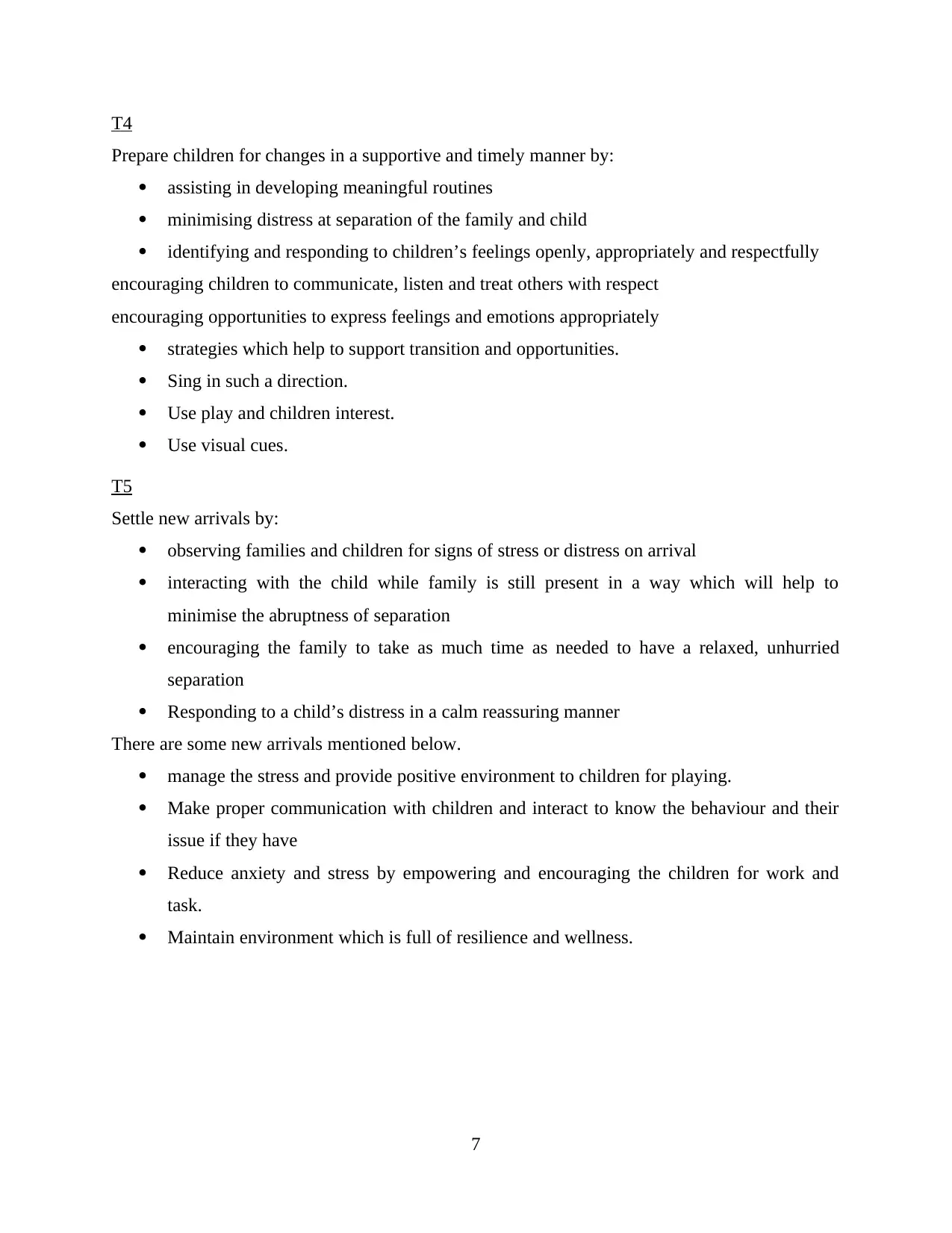
T4
Prepare children for changes in a supportive and timely manner by:
assisting in developing meaningful routines
minimising distress at separation of the family and child
identifying and responding to children’s feelings openly, appropriately and respectfully
encouraging children to communicate, listen and treat others with respect
encouraging opportunities to express feelings and emotions appropriately
strategies which help to support transition and opportunities.
Sing in such a direction.
Use play and children interest.
Use visual cues.
T5
Settle new arrivals by:
observing families and children for signs of stress or distress on arrival
interacting with the child while family is still present in a way which will help to
minimise the abruptness of separation
encouraging the family to take as much time as needed to have a relaxed, unhurried
separation
Responding to a child’s distress in a calm reassuring manner
There are some new arrivals mentioned below.
manage the stress and provide positive environment to children for playing.
Make proper communication with children and interact to know the behaviour and their
issue if they have
Reduce anxiety and stress by empowering and encouraging the children for work and
task.
Maintain environment which is full of resilience and wellness.
7
Prepare children for changes in a supportive and timely manner by:
assisting in developing meaningful routines
minimising distress at separation of the family and child
identifying and responding to children’s feelings openly, appropriately and respectfully
encouraging children to communicate, listen and treat others with respect
encouraging opportunities to express feelings and emotions appropriately
strategies which help to support transition and opportunities.
Sing in such a direction.
Use play and children interest.
Use visual cues.
T5
Settle new arrivals by:
observing families and children for signs of stress or distress on arrival
interacting with the child while family is still present in a way which will help to
minimise the abruptness of separation
encouraging the family to take as much time as needed to have a relaxed, unhurried
separation
Responding to a child’s distress in a calm reassuring manner
There are some new arrivals mentioned below.
manage the stress and provide positive environment to children for playing.
Make proper communication with children and interact to know the behaviour and their
issue if they have
Reduce anxiety and stress by empowering and encouraging the children for work and
task.
Maintain environment which is full of resilience and wellness.
7
Secure Best Marks with AI Grader
Need help grading? Try our AI Grader for instant feedback on your assignments.

8

9
1 out of 12
Related Documents
Your All-in-One AI-Powered Toolkit for Academic Success.
+13062052269
info@desklib.com
Available 24*7 on WhatsApp / Email
![[object Object]](/_next/static/media/star-bottom.7253800d.svg)
Unlock your academic potential
© 2024 | Zucol Services PVT LTD | All rights reserved.





